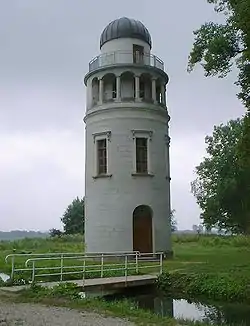
Friedrich II. Graf von Hahn (July 27, 1742 – October 9, 1805) was a German nobleman, a philosopher and astronomer born in Neuhaus, Holstein, Germany. He suggested the Doppler effect before Doppler.[1]
Career
Observatory
In 1793 Von Hahn started the construction of a private observatory, the first in Mecklenburg, which was well equipped.[2] He owned some of the largest mirrors made by William Herschel and precision instruments for determining the position of stars. He used his instruments in order to observe various stars, including the sun, planets, and nebulae.
Discoveries and observations
Von Hahn spent a significant amount of time observing the nebula NGC 3242, originally discovered by William Herschel. He documented the change in position and shape of the nebula over the course of a year. He also observed the Mira star system, which he had erroneously thought to be a nebula. The discovery Von Hahn in best known for is his 1800 discovery of the central star in the Ring Nebula M 57, in the constellation, Lyra.[2] This discovery contributed to Antoine Darquier de Pellepoix's discovery of the nebula 21 years earlier.[3]
Death and memory
He died in Remplin, Mecklenburg, Germany on October 9, 1805 at the age of 63. After his death, his son, the "theatrical count" and father of author Ida, Countess von Hahn-Hahn, squandered his fortune and all books and instruments were sold. The best instruments were bought by Friedrich Wilhelm Bessel for the new observatory in Königsberg. One instrument is on display in the Deutsches Museum in Munich. His herschelian telescope was acquired in 1812 by the Neapolitan astronomer, Federigo Zuccari, for the new Capodimonte Observatory.[4] Now the mirror of this telescope is part of the Observatory Museum collection.
He is honoured together with Otto Hahn by the lunar crater Hahn.
References
- ↑ Hockey, Thomas (2009). The Biographical Encyclopedia of Astronomers. Springer Publishing. ISBN 978-0-387-31022-0. Retrieved August 22, 2012.
- 1 2 Steinicke, Wolfgang (2010-08-19). Observing and Cataloguing Nebulae and Star Clusters: From Herschel to Dreyer's New General Catalogue. Cambridge University Press. ISBN 978-1-139-49010-8.
- ↑ O'Dell, C. Robert; Guttridge, Nicky (May 23, 2013). "Most detailed observations ever of the Ring Nebula". Hubble Space Telescope. Retrieved May 12, 2020.
- ↑ Gargano, Mauro (2012). "The development of astronomy in Naples: the tale of two large telescopes made by William Herschel" (PDF). Journal of Astronomical History and Heritage. 15 (1): 30–41. doi:10.3724/SP.J.1440-2807.2012.01.04. ISSN 1440-2807. S2CID 220757668. Archived from the original (PDF) on 2016-07-03. Retrieved 2018-04-21.